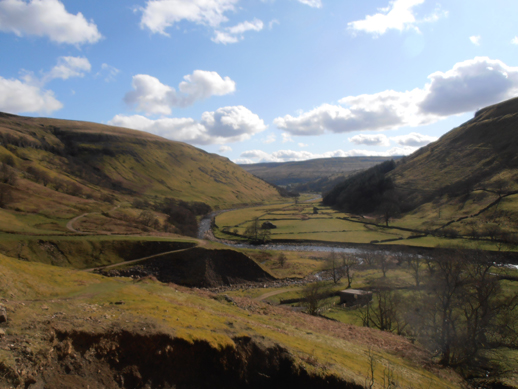by Lisa Samson
Pale smudges of cloud dangle above distant hills that graduate in many shades of charcoal. Grey skies hang over fields of just-turned sods, where a kestrel swoops in search of mice and, before we are ten minutes drive from home, a heron flies above our car, a red kite circles over trees and we see a buzzard, hungrily scouring the earth. We see more birds of prey near our urban home than we do in the remote wilds of Swaledale, where we are headed.
It is a brown day in Swaledale: damp ferns and burnished heather hug the hillsides and the tarnished leaves are more beautiful in their dying glory than at the height of spring. After weaving along the winding lane leading from the lower dale, we park in the farm car park at Keld and pay £2 in the honesty box, then slither down the path to the waterfall below the village. Keld means ‘running water’ in Norse. The spray from the fall refreshes me and I consider dipping my feet in the water but it is too cold today. This green dell, nestling in the hillside at the top of the valley, is a place of lovers’ trysts in my novel The Lovebegot that is set in Swaledale. It is also where the Pennine Way crosses the Coast to Coast Walk, a crossroads that Celts believed was where the underworld meets the celestial. But there are a few Rowan trees to ward off witches. The wind has already stripped the Rowan trees and their berries float in the foam of the pool, bloody jewels to be carried downstream to the lower dale and on to Richmond.
We climb the steep track towards Muker, kicking the corpses of dead rabbits away from our dog’s snapping jaws. The rusty seat of an abandoned tractor, sunk into the hillside for decades, marks the place where the track forks into two paths, one heading up to the remains of Crackpot Hall and the other leading on to Swinner Gill and Muker. Once called Crakepot, a place of crows, the hall has a forlorn and ghostly air and there is a tale of a wild child of four who lived here once.
We continue down the track to Swinner Gill and cross the wooden bridge at the foot of the crumbled stone ruins of the Swinner Gill Smelting plant that used river water to separate the ore from the iron. The water flowing down here is always tea coloured, the colour of ore. We sit to eat our lunch a little further on and stare across the river at the single wall of a stone dwelling, one of the many carcasses of coal miners or shepherds houses. It has a single window and sits like a theatre set exposed on the hill side, testament to the lives once lived there. Until last century, there was a thriving lead mining industry here that dated back to Roman times.
After tea next to a blazing fire in the Muker café, we set off back to Keld along the near side of the river. A cow in the meadow becomes agitated by our dog and, sensing its unease, the rest of the herd shamble closer but by that time we have scrambled over the stile. We’ve got another field of cows to walk through and, excited by his near run-in, the dog yelps and jerks at his leash. I head uphill close to the dry stone wall and crawl under a broken fence. Pleased with myself, I call out to the rest of the family and hold the fence up as they follow. Then I look behind me. A few metres away, guarding an open gateway, is a hulking ram with beard and horns the size of antlers, surrounded by his harem of munching sheep. Just like the biggest Billy Goat Gruff.
My husband marches through the gate dragging the dog behind him and my son follows. Whimpering, I edge along the top of the field, not daring to take my eyes off the ram lest it should toss me over the wall. Rather than walk through the open gateway, I clamber over the wall, displacing stones and bruising my legs. As I land on the other side, the ram finally makes its move, but I swing the gate shut, startling it so that it staggers backwards. It is easily cowed.
The sun disappears below the hills as we slither along the river bank above Kisdon Force. The water rumbles like distant thunder. This is the dank side of the river, never more so than on a late afternoon in winter. The wood is a quagmire of mud and negotiating the slope is a little like walking in thick snow with rackets on your boots. My boots gather a thick layer of mud that cushions my fall as I let each foot sink as far as it can go before shifting my upper body. On the steep slopes of Kisdon Hill above us, hidden from view, are many criss-cross paths worn by miners and shepherds over the centuries. Legend has it that the miners, ever mindful of the need to use all the daylight hours available, used to knit as they walked along. There was a special tool for knitting socks and they fastened the wool to their belts. They can only have done so in the summer months, because walking here in winter requires all your arms and legs.
